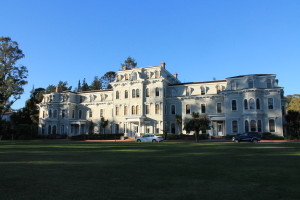In a presentation to a packed room, Micheline Marcom, a Mills English professor and co-founder of the New American Story Project (NASP), described the narrative project about Central American refugees seeking asylum as a “novel in voices.”
On Oct. 27, the Student Union hosted Welcome Children: Voices of the Central American Refugee Crisis, an event created by NASP with the goal of unpacking and exploring shared stories and artwork of refugees.
Founded in the spring of 2015 by Marcom and Claire Calderón, NASP is an organization that digitally documents, transcribes and shares the stories of unaccompanied minors arriving at the United States border seeking asylum, mostly from Central America, particularly Honduras, El Salvador and Guatemala. These three countries are called the Northern triangle, known for gang violence and impunity by the government.

Applying for U.S. asylum is a complicated process, but in simplest terms, it requires making a case that harm has happened in the country that the person is fleeing from, and to return would open the possibility for further harm. Currently called ‘migrants,’ the U.S. government has not designated this group of people ‘refugees’ yet, and does not provide them legal representation, even for children. This forces them to often represent themselves.
The project began when Marcom and nine graduate students from Mills, including Calderón, visited a Fremont High School classroom where the majority of students were unaccompanied minors granted asylum. They started with a free write, but then found that interviewing and letting the kids tell their stories resonated more with the kids. Now, NASP has expanded to include attorney and writer Sara Campos, photographer Ed Ntiri, videographer Lonny Shavelson, and blogger and writer Deborah Sherman who also built NASP’s website.
“Welcome Children“ gave ample time for people to wander the room, notice candles lit under paintings, observe photographs of the children and families that have been granted asylum, and listen to live music played by Amor Porteño. There were video clips of a few interviews, just a taste of the amount of work the group put into sharing these stories.
“It tugs at me, and I think it will tug at other people as well,” Campos said. “It’s a new way to tell a story and [activate] communities around an issue.”
NASP is not a group of journalists, and openly acknowledges this fact. They are a self-proclaimed group of artists and storytellers working together to provide an online platform for the stories of refugee children to be heard.
“This is also a project very much about art and advocacy and how artists respond to humanitarian crises,” Marcom said. “My hope is to help us see each other and understand each other across our borders.”
Before the event, the Union Salvadoreña de Estudiantes Universitarios (USEU), a new student club on campus for Central American students, hosted a pre-reception in the Solidarity Lounge. The original plan was to greet the Central American high school students interviewed in the project, but when they did not show up, it became a space of community for Central Americans and their allies. Mills students, including members of USEU and the Latinx Student Collective (LSC), met with teachers from Oakland Unified School District, lawyers from Central Legal and Patricia Segura, the Head of the Newcomer Program at Fremont High School, in the lounge to network and build community over pan dulce.
While it was agreed that the event was a good fundraising opportunity and that its goal of bringing voice and importance to these issues is valuable, many Latinx and Central American students were left feeling excluded, voiceless, and unsure about how they felt about the project. Many students who have recently come from Central America even felt triggered by the lack of recognition of Mills students who have experienced the same traumas as the high schoolers featured in the project.

“The event was clearly not geared for [Mills] students,” Emmely Tot Mairena, co-founder of USEU said. “So it was very awkward for all of us to be there. USEU was unaware of how it would all go down.”
USEU hopes that through the awareness raised on this issue through NASP, and after networking with people during the pre-reception, they can build an empowerment program of some kind for the students in Oakland.
“I don’t know if we want to work with [NASP],” Andrea Ortiz Galdámez, co-founder of USEU said. “Our goal was to meet the kids but they couldn’t come and that’s fine, I understand. We still got to talk to their teachers and start thinking about an empowerment program.”
As the community of undocumented students grows at Mills, the importance and ability to create a mentorship program with Oakland Unified high school students has become more pressing and possible. Arely Zimmerman, Mills ethnic studies professor, has written articles and books on how social media can be a source of empowerment and healing for undocumented youth.
“With thousands of Central American unaccompanied minors in Oakland,” Zimmerman said, “We are presented with an opportunity for Mills students and faculty to partner with local high schools, social service organizations and legal professionals to do so.”
You can check out the NASP website at newamericanstoryproject.org, and follow on social media or donate.



